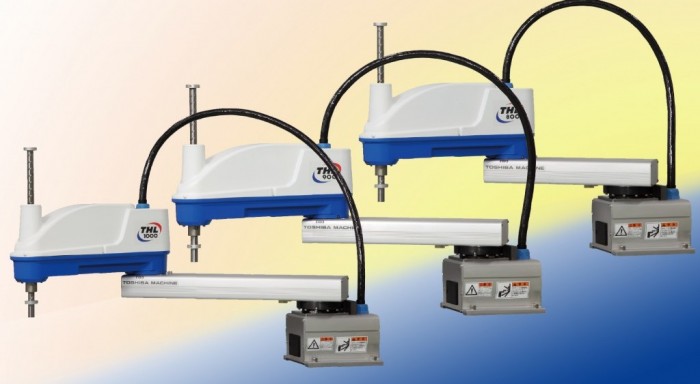Toshiba Machine THL SCARA robots offers a more affordable and flexible automation

Photo by TM Robotics (Europe) Ltd
Since their launch in Europe last year, TM Robotics’ Toshiba Machine THL SCARA robots have been the hot sellers. Their popularity is no doubt due in part to their relatively low cost compared with similar performance specifications, but their low mass has been a benefit to system integrators and low energy consumption is a bonus for end users. They are ideal in stand alone applications, but their ease of integration holds great appeal to machine builders and integrators too.
The Toshiba Machine THL models satisfy the growing demand for affordable, flexible automation in applications outside of traditional industries such as packaging, materials handling and welding where robots are commonly deployed.
The aim was to achieve low mass and low inertia with the necessary rigidity from which high accuracy is attained. Reduction in mass is thanks to the use of lightweight extruded aluminum mechanical components that have a series of ribbed sections to provide rigidity. As a result, smaller servo motors have been fitted. Moreover, because the lightweight system generates substantially less inertia a simplified gearbox has been used.
The THL range is up to 50% lighter than other Toshiba Machine models and the robots consume 50% less electricity. Performance compares favorably with other models and the new robots feature easier maintenance than previously.
Available on 300mm (11.8″), 400mm (15.7″), 500mm (19.7″), 600mm (23.6″), 700mm (27.6″), 800mm (31.5″), 900mm (35.4″s)and 1000mm (39.4″) arm lengths, the next surprising revelation is that across all models there are just three price points: THL300 and 400 are one price; THL500, 600 and 700 are one price; and the THL800,900 and 1000 are one price. TM Robotics (Americas) explains that since the only difference between the robots is the length of the extruded aluminum tube that forms the arm’s main beam, the cost difference is negligible across each of the three groups of robots. Cost savings have also been achieved by streamlining the manufacturing process and by standardizing on components such as motors and gearboxes across the range.
Each robot has four axes of movement including ±360° rotational, with a working envelope of ±125° on the first axis and ±145° on axis two. Maximum composite speeds using axes one and two are impressive while cycle times, even with maximum payloads are breathtakingly fast. The allowable moment of inertia is just 0.2kg/m2 (0.48 lb/ft2) and thanks to the use of absolute encoders repeatability in X-Y is a mere 0.01mm (4/1000 inch).
For more information, please visit http://www.tmrobotics.co.uk
News Categories
- » NEWS HOME
- » Automation & Robotics
- » Industry 4.0
- » Material Handling
- » Sensors
- » Quality & Testing
- » Machine Vision
- » Laser & Optics
- » Metalworking
- » Motion Control & Drives
- » Hydraulics & Pneumatics
- » Process Industry
- » Renewable Energy
- » Agriculture
- » Home & Office Furniture
- » Environmental Tech




